History and description
The palace stands on part of a block formerly belonging to the Spinola and the Grimaldi (family) then rebuilt to house the De Franchi Toso. The various properties in the area were acquired by Bernardo and Giuseppe De Franchi Toso, who in 1563 ordered the construction of the palace that was to house Gerolamo De Franchi Toso — the latter doge of the Republic of Genoa in the two-year period 1581—1583 — and belonged to the family until 1818. The De Franchi family partially maintained the pre-existing perimeter walls, in particular on the Spinola alley where there are still blocks of squared stone from the late medieval portico that had been filled in in the 16th century.
The building, with 19th-century superelevations, has a portal in doric style, which, through the atrium partitioned by a workshop, leads onto a large loggia courtyard. [1]
With the bombing of World War II, the palace suffered serious damage to its interior decorations. Today, it is possible to admire two monumental halls with frescoes by Bernardo Castello, Scenes from Jerusalem Delivered, and by Domenico Fiasella, Samson Exterminating the Philistines. The frescoes in the Castle were executed in the first decade of the 17th century, after the painter, who had his studio in the same Piazza della Posta, had illustrated the Genoese edition of the Gerusalem Delivered of 1590, [2] having been in Ferrara shortly before to meet the Tasso. [3] In the centre of the salon is depicted the siege of Jerusalem with the help of the siege tower, and in the six surrounding panels the stories of Godfrey of Bouillon. On the ceiling of the other hall, however, Fiasella depicts the famous biblical episode of Samson defeating the Philistines armed only with a donkey's jaw. [4]
Following a period when the palace was owned by Count Amedeo Umberto Alberti, its two noble floors later became the provincial headquarters of the Italian Socialist Party from 1952 to 2003, when ownership of the building's noble floors was sold for just under 1 billion lira to private individuals. [5]

Valerio Castello born in Genoa, was an Italian painter of the Baroque period and one of the pre-eminent Ligurian painters of his time. His art drew inspiration from a wide range of sources. He painted on canvas and fresco.
Bernardo Castello (1557–1629) was an Italian painter of the late-Mannerist style, active mainly in Genoa and Liguria. He is mainly known as a portrait and historical painter.

Palazzo Bianco is one of the main buildings of the center of Genoa, Italy. It is situated at 11, via Garibaldi.

The Doge's Palace is a historical building in Genoa, northern Italy.

Genoa is a city in and the capital of the Italian region of Liguria, and the sixth-largest city in Italy. In 2023, 558,745 people lived within the city's administrative limits. While its metropolitan area has 813,626 inhabitants. Over 1.5 million people live in the wider metropolitan area stretching along the Italian Riviera.

The Palazzo Angelo Giovanni Spinola is a palace located in Via Garibaldi, in the historical center of Genoa, in Northwestern Italy. It was one of the 163 Palazzi dei Rolli of Genoa, the selected private residences where the notable guests of the Republic of Genoa were hosted during State visits. On 13 luglio del 2006 it was included in the list of 42 palaces which now form the UNESCO World Heritage Site Genoa: Le Strade Nuove and the system of the Palazzi dei Rolli. Now owned by a bank, it is possible to visit the areas open to the public.

The Palazzo Doria or Palazzo Andrea e Gio. Batta Spinola is a palace located in Via Garibaldi, in the historical center of Genoa, in Northwestern Italy. It was one of the 163 Palazzi dei Rolli of Genoa, the selected private residences where the notable guests of the Republic of Genoa were hosted during State visits. On 13 luglio del 2006 it was included in the list of 42 palaces which now form the UNESCO World Heritage Site Genoa: Le Strade Nuove and the system of the Palazzi dei Rolli.

The Palazzo Spinola di Pellicceria, also known as Palazzo Francesco Grimaldi, is a palace located in piazza di Pellicceria in the historical center of Genoa, Northwestern Italy. The palace was one of the 163 Palazzi dei Rolli of Genoa, the selected private residences where the notable guests of the Republic of Genoa were hosted during State visits. On 13 luglio del 2006 it was added to the list of 42 palaces which now form the UNESCO World Heritage Site Genoa: Le Strade Nuove and the system of the Palazzi dei Rolli. It is currently owned by the Ministry of Cultural Heritage and Activities and Tourism and houses the National Gallery of Art in Palazzo Spinola.
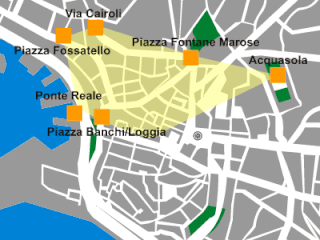
Maddalena is a neighbourhood in the old town of the Italian city of Genoa. It was one of the six sestieri of ancient Genoa. At present it is part of the Genoa's city Municipio I.

The palazzo Pantaleo Spinola' or palazzo Gambaro' is a building located in via Garibaldi (Genoa) at number 2 in the historical centre of Genoa, included on 13 July 2006 in the list of the 42 palaces inscribed in the Rolli di Genova that became World Heritage by UNESCO on that date. The building is now the headquarters of the Banco di Chiavari e della Riviera Ligure.

The palazzo Baldassarre Lomellini also known as palazzo di Cristoforo Spinola' or palazzo Campanella is a building located in via Garibaldi at number 12 in the historical centre of Genoa, included on 13 July 2006 in the list of the 42 palaces inscribed in the Rolli di Genova that became World Heritage by UNESCO on that date.
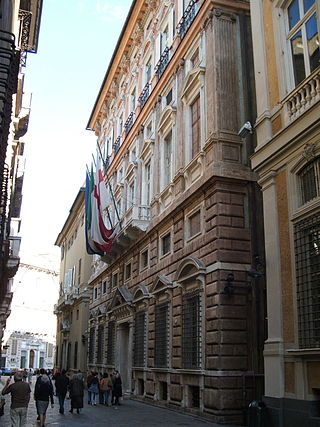
The Palazzo Carrega-Cataldi or Palazzo Tobia Pallavicino is a building located in via Garibaldi (Genoa) at number 4 in the historic centre of Genoa, included on 13 July 2006 in the list of the 42 palaces inscribed in the Rolli di Genova that became World Heritage by UNESCO on that date. The building is now the headquarters of Genoa's Chamber of Commerce.
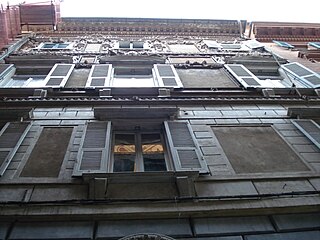
The Palazzo Tommaso Spinola', also known as Palazzo Tomaso Spinola di Luccoli or Palazzo Spinola Pessagno, is a building located in salita di Santa Caterina at number 3 in Genoa, included on 13 July 2006 in the list of the 42 palaces inscribed in the Rolli di Genova that became World Heritage by UNESCO on that date.
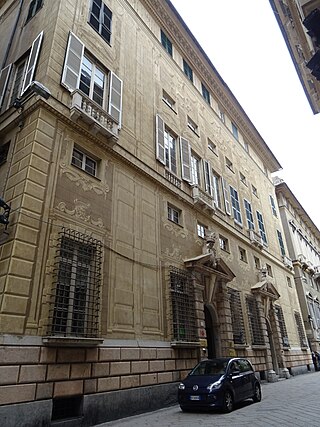
The palazzo Cattaneo-Adorno or palazzo Lazzaro e Giacomo Spinola' is a building located on via Garibaldi, in the historical centre of Genoa, marked by house numbers 8 and 10, included on 13 July 2006 in the list of 42 palaces inscribed in the Rolli di Genova, which became World Heritage by UNESCO on that date. It houses a remarkable cycle of Baroque frescoes by Lazzaro Tavarone.
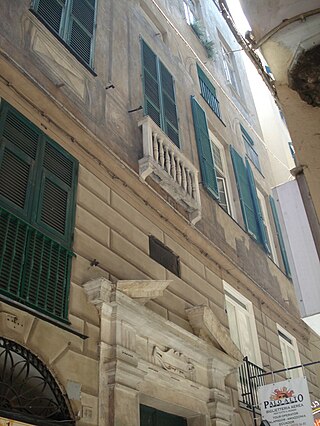
The Palazzo Stefano De Mari is a building located in Via San Luca at no. 5 in the Mercato di Banchi area in the historic centre of Genoa, included on 13 July 2006 in the list of the 42 palaces inscribed in the Rolli di Genova that became World Heritage by UNESCO on that date.

The Palazzo Giacomo Lomellini, also known as the Palazzo Patrone, is a building located in Largo Zecca at number 2 in Genoa, included on 13 July 2006 in the list of the 42 palaces inscribed in the Rolli di Genova that became World Heritage by UNESCO on that date.

The palazzo Belimbau, also known as palazzo Antoniotto Cattaneo' or Palazzo Francesco De Ferrari, is a building located in Piazza della Nunziata at number 2 in Genoa, included on 13 July 2006 in the list of the 42 palaces inscribed in the Rolli di Genova that became World Heritage by UNESCO on that date.
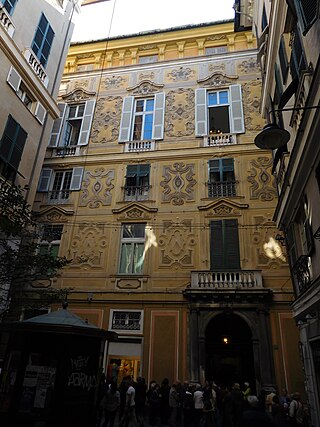
The Palazzo Nicolò Spinola di Luccoli, also called Palazzo del Marchese Stefano Franzone, or Palazzo Spinola Franzone, is a building located in Via Luccoli at number 23, in the area of the Soziglia Market in the historic centre of Genoa. The building was included in the list of palaces inscribed in the Rolli di Genova. The architecture, the decoration of the façade and the frescoes by Domenico Parodi in some of the interior rooms make it a relevant example of Genoese Baroque.

The Palazzo Vincenzo Imperiale is a building located in Campetto at number 8a, in the area of the Soziglia Market in the historical centre of Genoa. The building was included in the list of palaces included in the Rolli di Genova, UNESCO World Heritage List sites. Designed and decorated in the second half of the 16th century by Giovan Battista Castello, it constitutes one of the major Mannerist creations in Liguria.

The Palazzo Cristoforo Spinola is a building located in Piazza della Nunziata at number 6 in the historical centre of Genoa. The building was included, and still is, in the list of palaces inscribed in the Rolli di Genova.




















